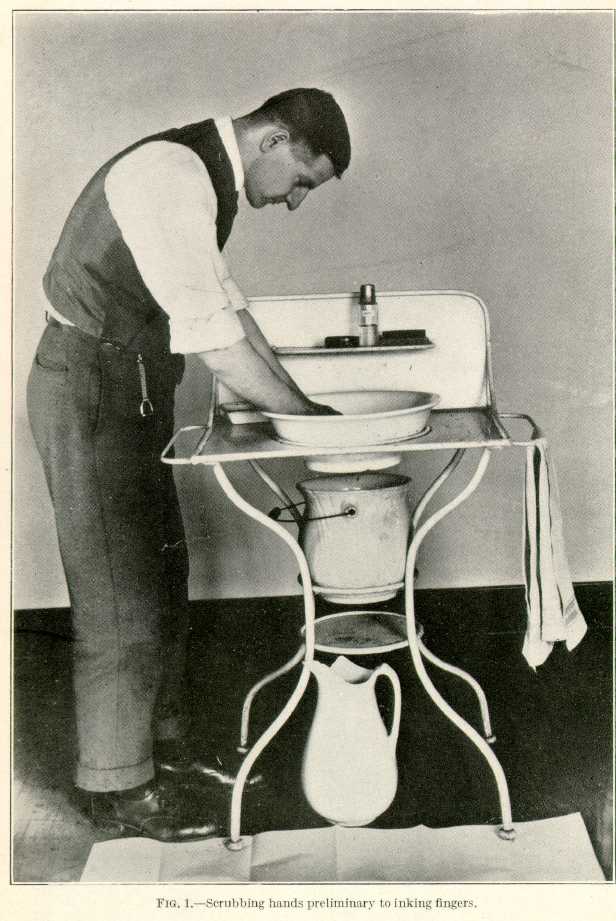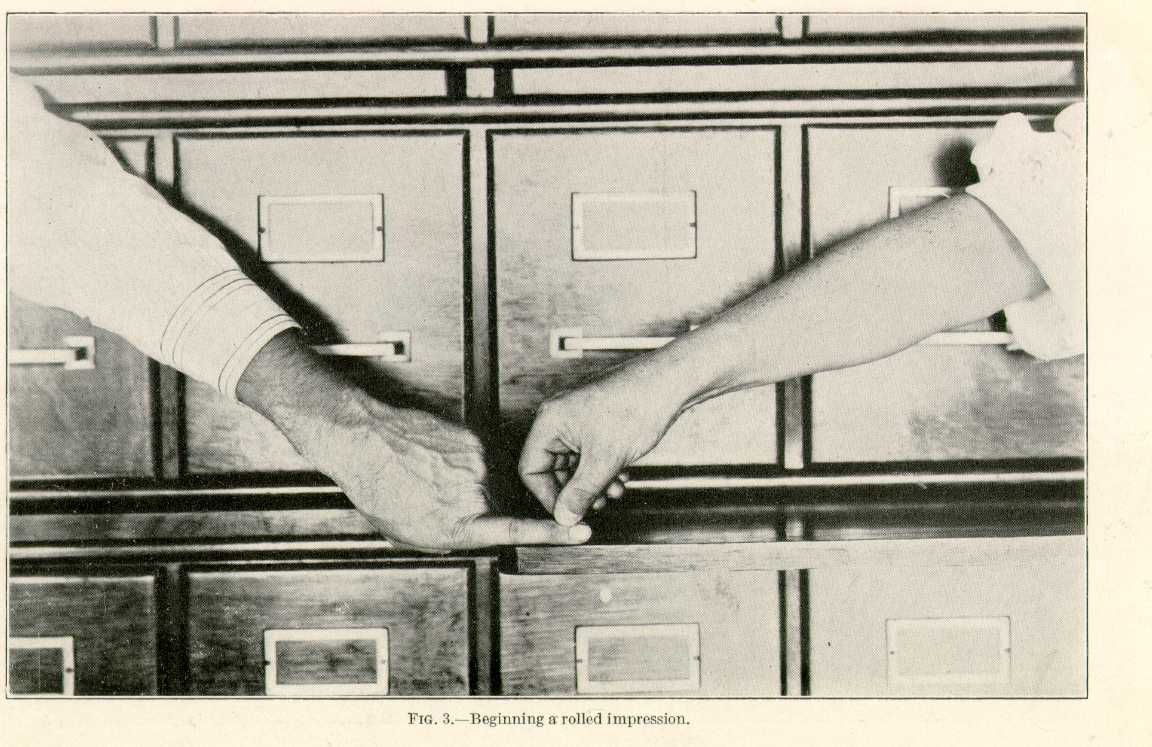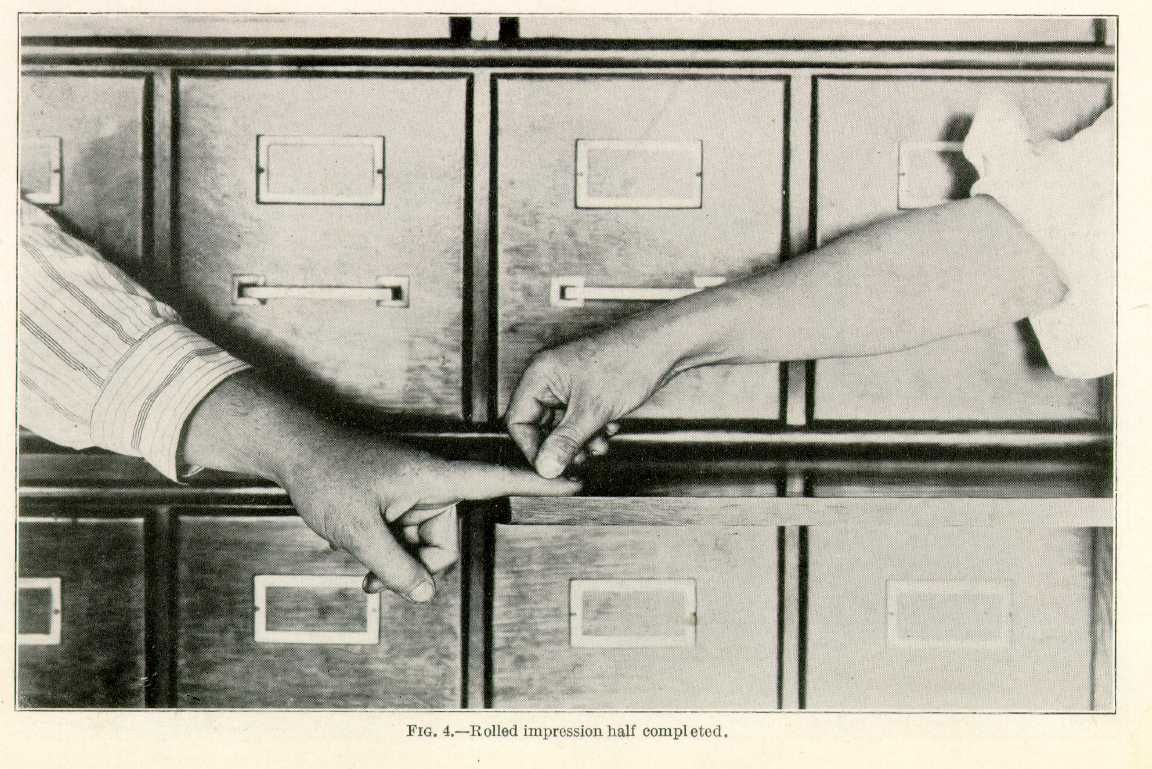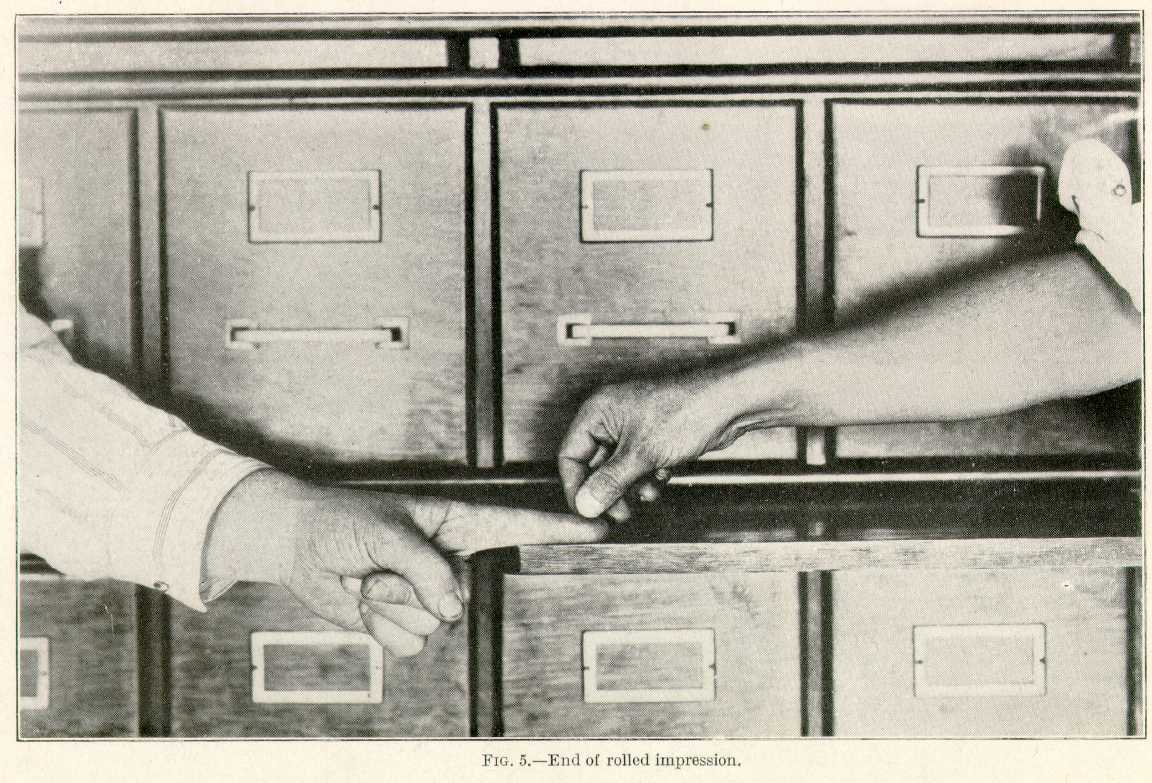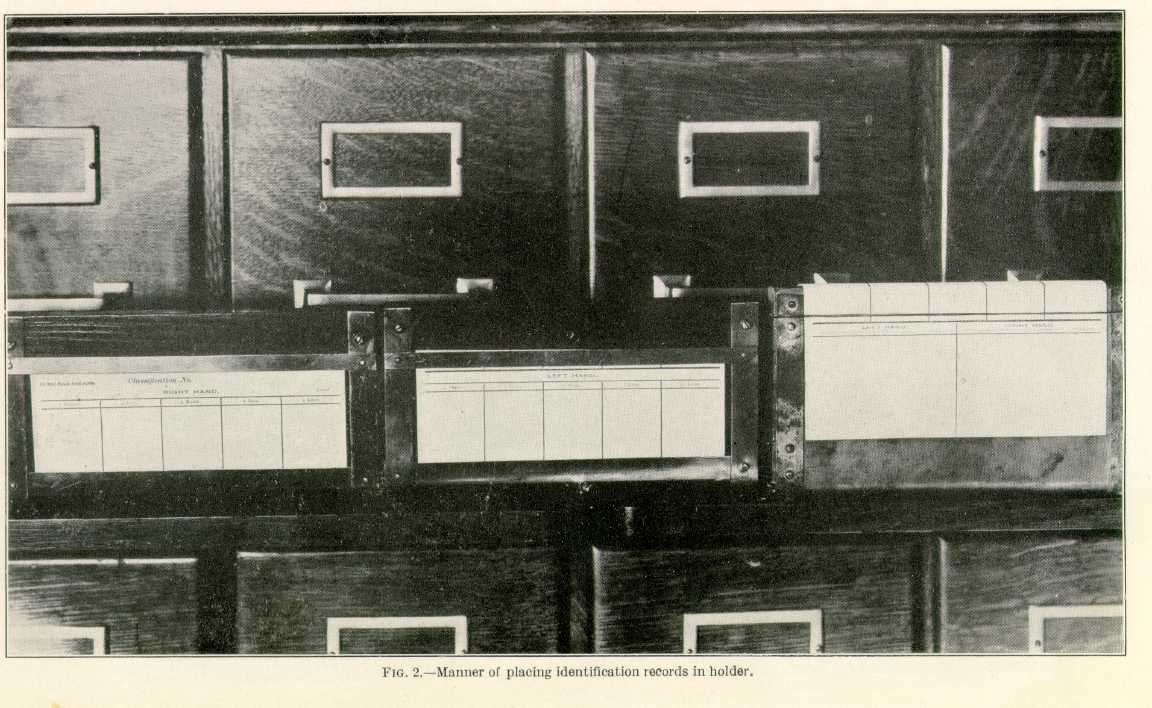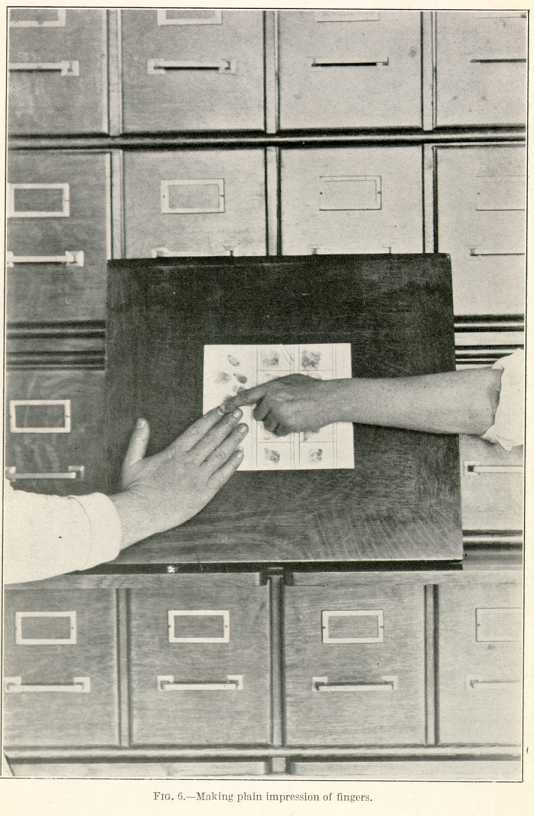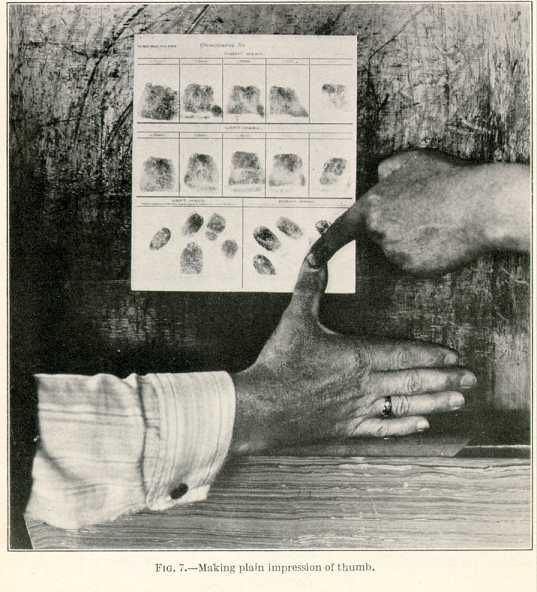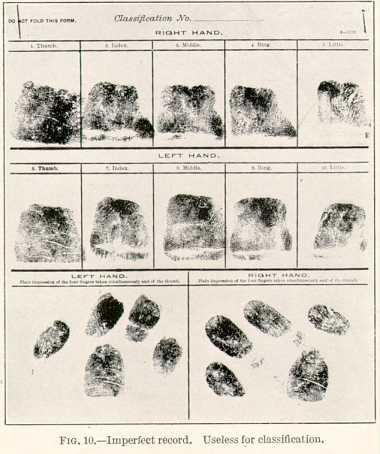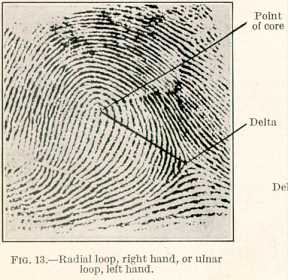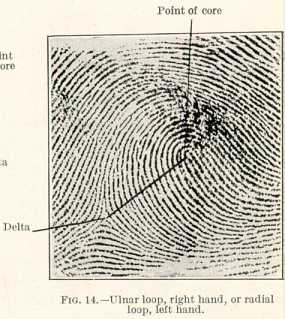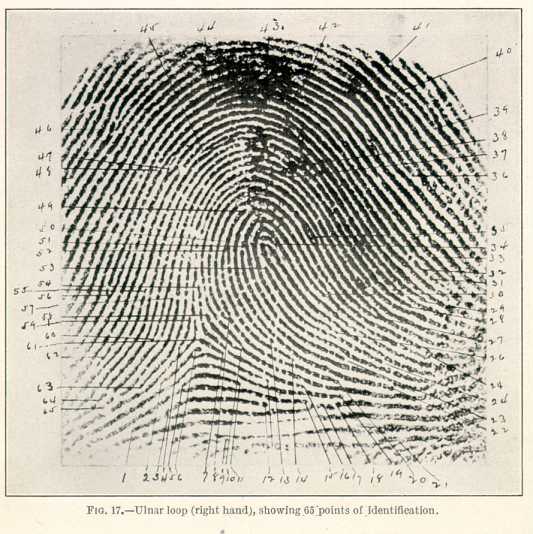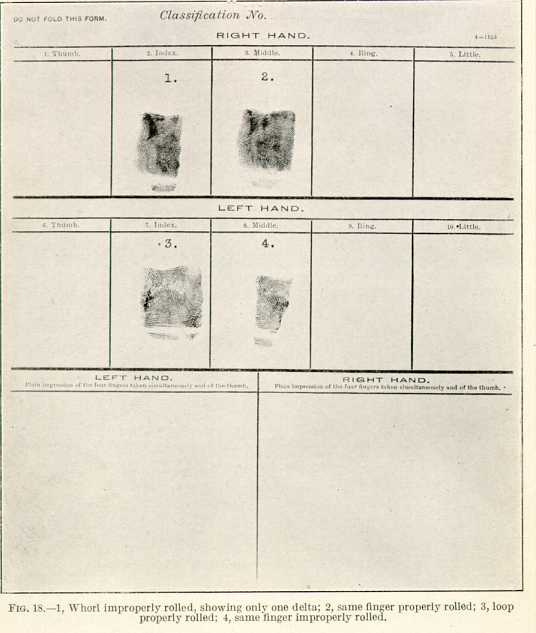| How to obtain good finger prints | ||
HOW TO OBTAIN GOOD FINGER PRINTS.
(SECOND EDITION.)
APPARATUS.
The apparatus for taking finger prints consists of a form holder, an ink plate, and a roller for spreading the ink on the plate.
Keep the roller and ink plate clean and free from dust, grit, or hairs, and the ink tube closed when not in use. When the day's work is finished, clean the ink from the plate and roller by means of a cloth and benzine. When not using the roller, rub it with a little sweet oil or lubricating oil before laying it away, to prevent the composition from becoming too hard.
Preparatory to taking finger prints squeeze a small quantity of ink from the tube and carefully work it, by use of the roller, into a thin film on the plate, the spreading of which may be facilitated by frequently turning over the roller. If too much ink is used, the impression will be blurred and consequently unsatisfactory. The thickness of the ink after being spread on the plate should be less than one-half the elevation of the ridges, and this can be tested by taking impressions.
The recruit should wash his hands thoroughly with soap and brush, using, if practicable, running water, especial care then being taken to rinse off all soap or lather with cold water. (Fig. 1.)
Failure to do this will cause white blotches to appear in the impressions. Immediately before placing the fingers on the inked plate the fingers should be well wiped with a cloth dampened with benzine or ether' which should remove all trace of grease, water, or perspiration.
Two kinds of impressions are used, "plain" and "rolled." A plain impression is obtained by pressing the bulb of the finger, with the plane of the nail parallel to the plane of the plate, on the inked plate and then on the paper in the same manner. A rolled impression is
It is absolutely necessary that the finger prints shall be clear, that the ridges shall be distinctly outlined, and that the "rolled" impressions shall be sufficiently large to include all the points needed for accurate classification, and free from blur. Black impressions are better than light ones if the spaces between the ridges are free from blur.
When the skin of the fingers is in poor condition, make special effort to get best results.
Entire palmer surface of first joint should be inked so that whole contour of pattern will be shown when finger is rolled.
Recruit should first be required to sign his name, and then to roll the impression of the right index finger in the space above his signature. This will eliminate entirely the possibility of the recruit signing other than his own identification record. Have only one recruit at a time present in the room where prints are being made, and complete and file each record before the next man enters or is taken up. In this way no other record than the one in question is available or within reach of the recruit being recorded, therefore he can sign no record but his own. Do not allow records to lie around, but file or otherwise dispose of them at once after completing examination.
In taking impressions, the operator himself should manipulate the hands of the recruit, who should be directed to relax his fingers and not to attempt to assist by adding to the pressure on the inked plate or on the paper. In order that the ink may be taken up on the finger evenly and in sufficient quantity, an unused part of the plate should be selected each time for inking the finger, and when no unused part of the plate remains the ink should be redistributed with the roller or the plate reinked. See that there are no clots of ink where the fingers are to be rolled on the plate.
The form holder, which is intended to prevent the form from moving about and blurring the print while impressions are being taken, will be used. The best results will be obtained with a table
To record the finger prints on Bureau of Navigation Form No. 2, place one of the blank forms in the holder (Fig. 2),
with the upper heavy black line appearing just above the upper edge of the holder; then take the rolled impressions, in the order named and in proper spaces on the form, of the thumb, index, middle, ring, and little fingers of the right hand, the impressions to be located on the form so that the flexure of the last joint is immediately above the folding line. This will leave room for a second print to be taken in the upper part of the space in case the first print is defective.
After the impressions of the fingers of the right hand have been taken, move the form in the holder until the lower heavy black line appears just above the edge of the holder; then take the rolled impressions of the fingers of the left hand in the proper spaces on the form.
After the rolled impression of each finger of both hands has been obtained, again move up the form in the holder, allowing sufficient space for the plain impressions. Then take a plain impression of the four fingers of the right hand at one time, the fingers being held together so as to bring the prints within the allotted space and a similar plain impression of the fingers of the left hand. Below the finger impressions take a plain impression of each thumb.
The method of obtaining the plain impressions is to take each of the fingers in turn and place the *bulbs only on the inked plate. When this is done, press the recruit's fingers together, and with his hand limp and flat (not bowed or arched) place it in the space shown on the form and press each finger at the base of the nail, lightly. No attention need be paid to the deltas in the plain simultaneous impressions, but the detail must be clearly defined. These impressions are used to determine if the rolled impressions ale in their proper sequence. (Figs. 6 and 7.)
A finger should not be noted missing if any portion of it beyond the flexure of the terminal joint remains. The end of a mutilated finger should, in all cases, be inked and recorded as in the case of a perfect digit.
Figure 10 shows impressions improperly taken. This record is so blurred that it is impossible to classify tile impressions, and consequently is of no value.
No amount of pressure by the operator should be used in making or inking rolled impressions. It is the pressure that causes the ink to more readily run in between the ridges. The finger tips should be allowed to touch the paper only with sufficient pressure to make a record.
Figure 8 represents the only standard which is satisfactory and it is desired that no record be forwarded which is not up to the standard.
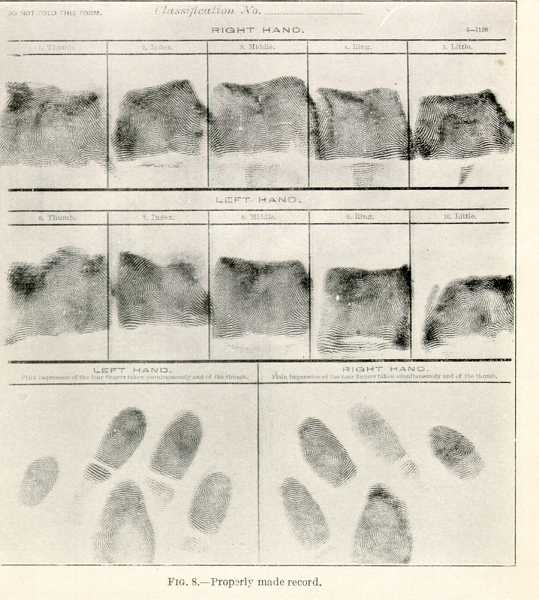
FIG. 8. — Properly made record.
[Description: Black and white photograph of a fingerprint record]
The utmost care should be taken in recording the impressions of the little fingers. From these fingers a subclassification number is obtained.
When the finger-print side of the form has been completed, the impressions will be inspected to make sure that they are clear and free from blur; that all deltas are shown in the rolled impressions, and that the whole contour of the pattern is shown. The rolled impressions will also be compared with the plain impressions for the purpose of ascertaining whether they are recorded in proper sequence. Any defective impressions will then be remedied by taking another print in the upper part of the proper space or by using a new form, if necessary. If the impressions are not recorded in proper sequence, a new form must be used, the old one being destroyed.
After the finger prints have been taken and examined, the opposite side of the form will be filled out and the personal description completed by noting on the outline figures the principal identification marks.
Before making the entries on the personal description side of the blank, allow the ink on the finger-print side to become sufficiently dry to prevent blurring by rubbing. A few minutes will be sufficient if the form is handled carefully and not rubbed about on the desk while the personal description is being entered. A sheet of blotting paper placed under the form will protect it to some extent. If an impression becomes blurred at any time, a new impression must be taken in the upper part of the proper space, or, if necessary, the imperfect form should be destroyed and a new blank used.
A delta may be formed by the bifurcation of a single ridge or by the abrupt divergence of two ridges that hitherto, had run side by side, thus: {illust.}
The core of a loop may consist either of an even or uneven number of ridges not joined together, thus: {illust.}
Arches.—In arches the ridges run from one side to the other, making no backward turn. Arches have no deltas. (Fig. 11.)
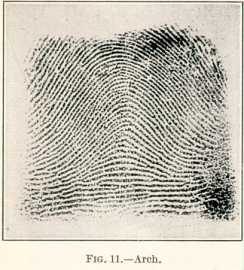
FIG. 11. — Arch.
[Description: Black and white close-up of the arch in a fingerprint]
Tented arches.—In patterns of the arch type the ridges near the middle may have an upward thrust, arranging themselves, as it were, on both sides of a spine or axis, toward which adjoining ridges converge. The ridges thus converging give to the pattern the appearance of a tent in outline, hence the name tented arch. Tented arches have no deltas. (Fig. 12.)
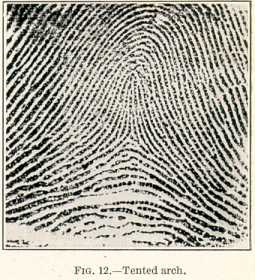
FIG. 12. — Tented arch.
[Description: Black and white close-up of a tented arch]
In loops some of the ridges make a backward turn but without twist; there is one delta. If the downward slope of the ridges about the core is from the direction of the little finger toward that of the thumb it is a radial loop. Figure 13 is a radial loop in the right hand.
The heavy black line drawn from the delta to the core indicates the ridges that are counted in classifying loops. In this impression the line cuts or crosses 16 ridges. If the downward slope of the ridges about the core is from the thumb side toward the little finger the loop is ulnar. Figure 14 is an ulnar loop in the right hand or a radial loop in the left hand. In this impression the heavy black line crosses 19 ridges. Be sure that the delta is shown if the impression is a loop.
Whorls.—In whorls some of the ridges make a turn through at least one complete circuit. There are two deltas. Whorls are single cored or double cored. (Fig. 15.)
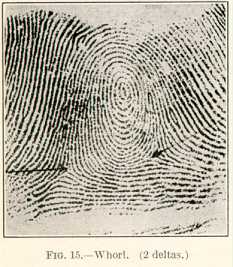
FIG. 15. — Whorl. (2 deltas.)
[Description: Black and white photograph (close-up) of whorl]
The right and left deltas in this impression are shown by the arrowheads. The deltas in whorls must always be shown, in order that the tracings may be properly made. In whorls the ridge traced starts from the left delta and is traced toward the right delta. When the ridge whose course is traced meets the corresponding right delta ridge the whorl is specialized as M; when this ridge goes inside of the right delta with three or more ridges intervening it is specialized as I; when the ridge traced goes outside of the right delta with three or more ridges intervening it is specialized as O.
Figure 16 is a composite. This pattern is classed as a whorl and has two deltas. The right and left deltas in this impression are shown by the arrowheads.
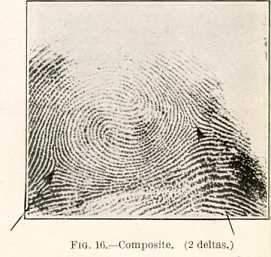
FIG. 16. — Composite. (2 deltas.)
[Description: Black and white photograph of print]
Figure 17 shows ridge characteristics used in establishing the identity of a person. Unless an impression is free from blur great difficulty is encountered in picking out the points of comparison between two impressions. Sixty-five points of comparison are shown on this impression which are free from blur and could all be used for purposes of comparison and identification with another print of the same individual.
Figure 18 (1) shows a whorl improperly rolled, with only one delta showing. It is impossible to make a correct tracing of a pattern rolled in this manner. Figure 18 (2) shows the same impression properly rolled.
Figure 18 (4) shows a loop improperly rolled, with the delta missing. The space between the delta and point of core in loops must be plainly shown and free from blur. This pattern is of no value and can not be properly classified. Figure 18 (3) shows the same pattern properly rolled.
Each operator should instruct his relief in the taking of finger prints, so that the Bureau of Navigation will be able to receive good finger-print impressions at all times.
The skin on the finger tips of the bodies of men which have been recovered from the water will be greatly wrinkled or shriveled, so that without some treatment the making of satisfactory prints may be difficult and even impossible. The way to overcome this is to inject water with a hypodermic syringe beneath the skin of the bulb of the finger. This will smooth out the skin for the impression.
HOW TO DEVELOP AN INVISIBLE FINGER-PRINT IMPRESSION.
If it is suspected that the impression is on a dark surface, glass, or metal, sprinkle it with gray powder or aluminum dust and then brush off with a camel-hair brush. This should bring out the print very clearly. Should the surface be white in color, graphite or powdered charcoal may be used.
If a camel-hair brush is not handy the powder may be blown off which will bring the same result as if brushed off.
Gray powder is composed of mercury and chalk.
In robbery cases this information should be very useful.
| How to obtain good finger prints | ||
